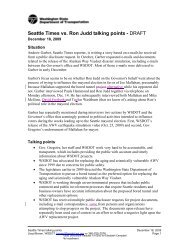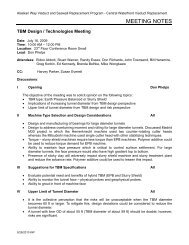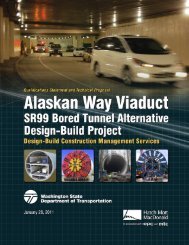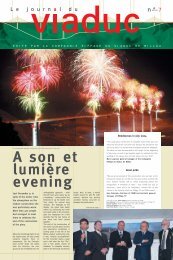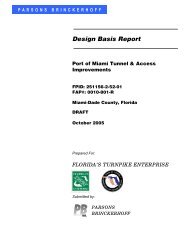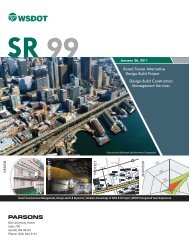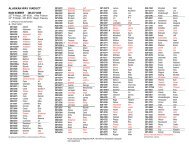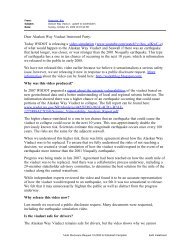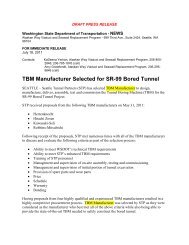SR99 Bored Tunnel-Assessment of Settlement Impacts ... - SCATnow
SR99 Bored Tunnel-Assessment of Settlement Impacts ... - SCATnow
SR99 Bored Tunnel-Assessment of Settlement Impacts ... - SCATnow
You also want an ePaper? Increase the reach of your titles
YUMPU automatically turns print PDFs into web optimized ePapers that Google loves.
Calculations utilizing the B&C method <strong>of</strong> determining building distortions andstrains for each building were performed using an Excel spreadsheet and VisualBasic s<strong>of</strong>tware. An explanation <strong>of</strong> this method is provided in Appendix D. Manualcalculations were performed to verify the accuracy <strong>of</strong> the spreadsheet calculations.Calculated strains were compared to the limiting strain values to determine the level<strong>of</strong> expected damage likely to be experienced. Results <strong>of</strong> the analyses are presented inSection 6.As the <strong>Tunnel</strong> Boring Machine (TBM) advances, a small volume <strong>of</strong> soil is empirically“lost” in the excavation process, even under the most carefully controlled tunnelingconditions. This lost ground may be defined as the small percentage <strong>of</strong> soil that isexcavated over-and-above the absolute minimum volume <strong>of</strong> soil excavated undertheoretically perfect tunneling conditions. The loss <strong>of</strong> this small volume <strong>of</strong> soil ismanifested as settlement <strong>of</strong> the ground surface above the tunnel alignment, the socalledsurface “settlement trough.”The shape, depth, and width <strong>of</strong> the settlement trough depend on many conditions,including soil type, depth <strong>of</strong> tunnel, and tunneling method. For the SR 99 <strong>Tunnel</strong>,the shape, depth, and width <strong>of</strong> the settlement trough have been estimated byShannon and Wilson, using classical settlement calculation methods, similar to thosedescribed in Attewell, Yeates, and Selby [1986].The front <strong>of</strong> the settlement trough develops along the surface in response to theadvancement <strong>of</strong> the TBM. For granular soil conditions (K=0.35), the advancement<strong>of</strong> the settlement trough can be described as follows: at any given time, the leadingedge <strong>of</strong> the settlement trough is located at the surface ahead <strong>of</strong> the TBM by adistance <strong>of</strong> approximately 0.8 to 1.0 times the tunnel depth. For K=0.5, thesettlement trough is located at the surface ahead <strong>of</strong> the TBM by a distance <strong>of</strong>approximately 1.0 to 1.3 times the tunnel depth. At that same time, at the surfaceposition directly above the TBM, the settlement trough has reached a depth <strong>of</strong>approximately one-half the maximum trough depth that will eventually develop afterthe TBM has moved well past its current location. At this same time, the settlementtrough has already reached its maximum depth behind the TBM by a distance equalto about 0.9 times the tunnel depth. Thus, for a vertical longitudinal section throughthe ground surface (a vertical section parallel to the tunnel axis), the front <strong>of</strong> thesettlement trough describes an “S” shaped curve: zero settlement at a location 0.9times the tunnel depth ahead <strong>of</strong> the TBM; one-half the maximum settlement at theposition <strong>of</strong> the TBM; and the maximum settlement at distances equal to or greaterthan 0.9 times the tunnel depth behind the TBM. In fact, the shape <strong>of</strong> this curve isdefined in analysis as the S-shaped Cumulative Distribution Function for a normal,or Gaussian, probability distribution.Once the TBM has passed any given position (by a distance <strong>of</strong> at least 0.9 times thetunnel depth), the settlement trough is “fully developed”, meaning that thesettlement at the center <strong>of</strong> the trough has reached its maximum value. For a verticaltransverse section through the ground surface (a vertical section transverse to theThe Alaskan Way Viaduct & Seawall Replacement Program March 2010Proposed SR 99 <strong>Bored</strong> <strong>Tunnel</strong> - <strong>Assessment</strong> <strong>of</strong> <strong>Settlement</strong> <strong>Impacts</strong> to Buildings 22Public Disclosure Request 11-0123 for Elizabeth Campbell - 2nd installment




